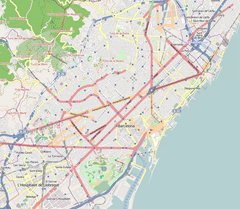
Trambesòs is a tram–light rail system in the Spanish autonomous community of Catalonia that links the Barcelona district of Sant Martí with Badalona and Sant Adrià de Besòs. Its name comes from the union of the words "tram", an abbreviation of the Catalan word for "tram" (tramvia), and "Besòs", the name of an area in the north of the Barcelonès region dominated by the Besòs River.

Passeig de Gràcia ) is an underground railway and metro station in Barcelona located under Passeig de Gràcia, in Eixample district. It is one of the Barcelona's busiest railway stations and important stop for Barcelona Metro network. It is served by Rodalies de Catalunya suburban railway lines R2 and regional lines R11, R13, R14, R15 and R16, and it is also served by TMB-operated Barcelona Metro lines L2, L3 and L4.

Provença is the name of a Ferrocarrils de la Generalitat de Catalunya station located under Avinguda Diagonal and Balmes street. The station is served by FGC-operated Barcelona Metro lines L6 and L7, and Metro del Vallès suburban metro lines S1 and S2. Diagonal is the name of an important station in TMB-operated Barcelona Metro network. It is named after Avinguda Diagonal, where the station is located together with Passeig de Gràcia. It is served by TMB-operated Barcelona Metro lines L3 and L5, and it is also connected with FGC station.

Plaça d'Espanya, also simply known as Espanya, is an interchange complex underneath Plaça d'Espanya, in the Barcelona district of Sants-Montjuïc, in Catalonia, Spain. It comprises the Barcelona terminus of the Llobregat–Anoia Line and a Barcelona Metro station complex served by lines 1 (L1) and 3 (L3). On the L1, the station is between Hostafrancs and Rocafort, and on the L3 it is between Poble Sec and Tarragona. The Llobregat–Anoia Line station is served by Barcelona Metro line 8 (L8), Baix Llobregat Metro lines S33, S4 and S8, and commuter rail lines R5, R6, R50 and R60. The services on the Llobregat–Anoia Line are operated by Ferrocarrils de la Generalitat de Catalunya (FGC), whilst the L1 and L3 are operated by Transports Metropolitans de Barcelona (TMB).

Zona Universitària is a station in the Barcelona Metro and Trambaix networks, in the Les Corts district of Barcelona. It is currently the western terminus of metro line L3 and L9. Also it's served by tram lines T1, T2 and T3. It is named after the Universitat de Barcelona campus of the same name.

Marina is a station in the Barcelona Metro and Trambesòs tram networks, at the boundary between the Eixample and Sant Martí districts of Barcelona. It is served by TMB line L1 and tram route T4. The station is named after the nearby Carrer de la Marina, and can be accessed from Carrer dels Almogàvers, and the crossing of Carrer de la Marina with the Avinguda Meridiana. It is adapted for disabled people.
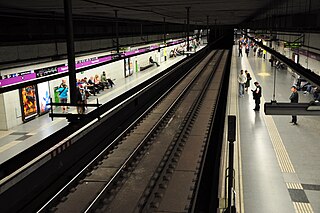
Sagrada Família is a metro station in Barcelona Metro network. It is named after the famous, and adjacent, Basílica i Temple Expiatori de la Sagrada Família, a church first designed by architect Antoni Gaudí and still under construction. It is served by TMB-operated Barcelona Metro lines L2 and L5.

Palau Reial is a station in the Barcelona Metro and Trambaix networks, in the Les Corts district of Barcelona. It is served by metro line L3 and tram lines T1, T2 and T3. The station draws its name from the nearby minor royal palace in Pedralbes built for Alfonso XIII in 1924, part of which nowadays hosts a Museum of Decorative Arts.

Plaça de Catalunya station, also known as Barcelona-Plaça Catalunya, Plaça Catalunya or simply Catalunya is a major station complex in Barcelona located under Plaça de Catalunya, the city's central square and a large transport hub. Many Rodalies de Catalunya, Barcelona Metro and Ferrocarrils de la Generalitat de Catalunya lines go through it and many bus routes link it with all of the districts of the city and most of the municipalities in its metropolitan area.
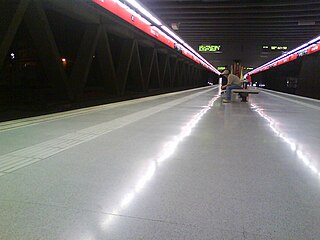
Mercat Nou is a Barcelona Metro station in the Sants-Montjuïc district of the city of Barcelona. The station is served by line L1. It was formerly called Mercado Nuevo until 1982.

Vall d'Hebron | Sant Genis is a Barcelona Metro station, in the Horta-Guinardó district of Barcelona, and named after the nearby Vall d'Hebron neighbourhood. The station is served by line L3 and is the northern terminus of line L5.

Plaça de Sants is a Barcelona Metro station, named after the nearby Plaça de Sants, in the Sants-Montjuïc district of the city of Barcelona. The station is served by lines L1 and L5.

Santa Eulàlia is a Barcelona Metro station, just inside the boundary of the municipality of L'Hospitalet de Llobregat with the city of Barcelona, and named after the nearby Santa Eulàlia neighbourhood. The station is served by line L1.

Gorg is a Barcelona Metro and Trambesòs complex named after the neighbourhood of the same name where the station is situated, in Badalona municipality. It is located on Avinguda del Marquès de Mont-Roig and very close to Palau Municipal d'Esports de Badalona, the home arena of the professional basketball club Joventut de Badalona. It is served by TMB-operated Barcelona Metro lines L2 and L10, and Trambesòs route T5.
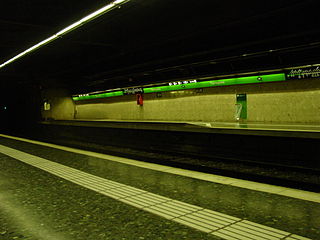
Tarragona is a station in the Barcelona Metro network in the Sants-Montjuïc district of Barcelona. It is served by line L3.

The Barcelona–Vallès Line is an unconnected standard gauge rapid transit and commuter railway line linking Barcelona with Sabadell and Terrassa via the Collserola mountain range, in Catalonia, Spain. Its name refers to the Catalan historical region of Vallès, whereby most part of the line runs. Plaça de Catalunya station serves as the Barcelona terminus of the line, where almost all its trains either start or terminate. The line then continues northwards and branches off twice before leaving the city limits. Its main route splits in two in Sant Cugat del Vallès, forming two major branches to Sabadell and Terrassa. It has 40 passenger stations in operation and a total line length of 48.1 kilometres (29.9 mi).

Arc de Triomf is a Rodalies de Catalunya and Barcelona Metro interchange complex. It is named after the adjacent triumphal arch of the same name near which it is situated, in the Barcelona district of Eixample in Catalonia, Spain. The Rodalies station is served by Barcelona commuter rail service lines R1, R3 and R4, as well as Girona commuter rail service line RG1 and regional line R12. The Barcelona Metro station is served by TMB-operated line L1.

Plaça del Centre, also known as Plaza del Centro, is a station in the Barcelona Metro network, on the border between the Les Corts and Sants-Montjuïc districts of Barcelona. It is served by line L3.

Maria Cristina is a station in the Barcelona Metro and Trambaix networks, in the Les Corts district of Barcelona. It is served by metro line L3 and tram lines T1, T2 and T3.
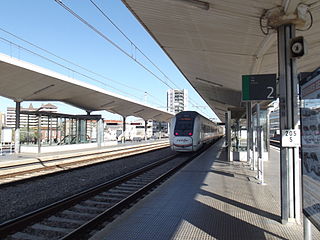
Girona is a railway station serving the city of Girona in Catalonia, Spain. It is located in the northern part of the municipality, lying at approximately 1 kilometre (0.62 mi) southwest of the city's historical centre.

